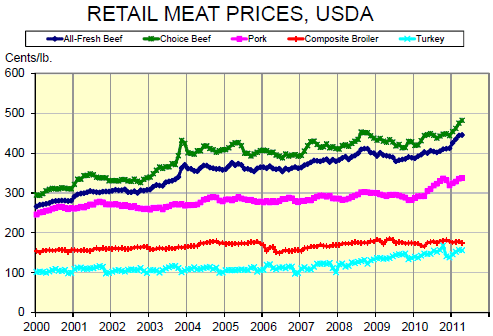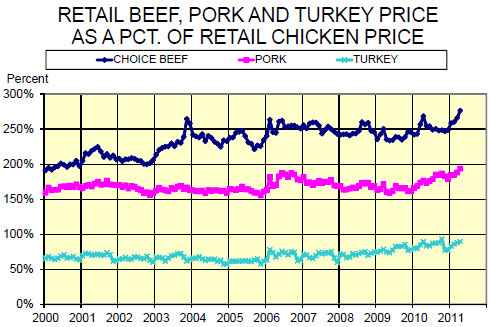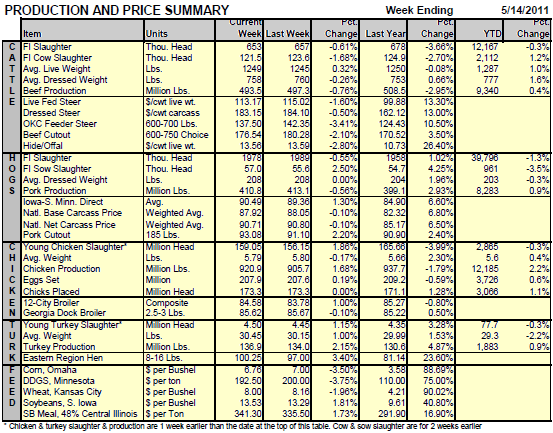



CME: Record Beef, Pork Prices; Chicken Prices Drop
US - "Who would have thought that an April Consumer Price Index of 224.9, reflecting 3.2 per cent inflation from one year ago, would get a sort of “Ho, Hum, nothing to worry about” reaction from virtually every analyst who cared to comment?" ask Steve Meyer and Len Steiner.But such is the present state of matter economic it appears and we find it very difficult to argue with the sentiment — given all of the circumstance and underlying factors, 3.2 per cent inflation is certainly not the worst thing that could be happening.
The 3.2 per cent figure for all items is the highest year-on-year increase since October 2008 when the CPI posted a 3.7 per cent annual increase. But the reason for the apparent comfort with a number that at one time would have put fear in the heart of every central banker in America is that it is primarily due to one factor — energy prices — and most analysts simply do not think they can keep rising at recent rates much longer. April’s CPI for Energy was 19 per cent higher than one year ago, driving prices of some other goods higher and threatening to put a damper on consumer expenditures for other goods. The CPI for transportation rose by 11.8 per cent versus one year ago.
The CPI for food and beverages was 3.1 per cent higher than in April 2010 while just the food component rose by 3.2 per cent. The main driver of that growth, though, was meats and dairy products whose prices rose by 9.8 per cent and 6.3 per cent, respectively. Meanwhile, poultry prices, food prices and energy prices are far from independent, of course. Higher oil prices have provided profitable opportunities for ethanol refiners. Ethanol profits have allowed them to bid more for corn and use more corn, driving meat and dairy production costs higher — a factor that will eventually show up in food price indexes. This year’s record high beef and pork prices (more later) are the result of precisely the same oil and grain price patterns in 2007 and 2008.
The good side of the consumer price story, of course, is that the CPI for all items except food and energy is only 1.3 per cent higher than last year, a rate that few are going to get too concerned about.
The same Bureau of Labor Statistics (BLS) data that go into the Consumer Price Index computations are also used by USDA to estimate monthly meat and poultry prices. Those data indicate another record-high month for beef prices and a new record for pork prices in April. Choice beef sold in April for an average price of $4.82/lb., 8.5 per cent higher than last year and 1.6 per cent higher than last month’s previous record. The average price of all fresh beef was $4.45/lb, 10.6 per cent higher than last year and 0.3 per centhiigher than last month. Pork sold for an average of $3.38/lb. in April, 15.7 per cent higher than one year ago and 1.4 cents/lb. higher than last October’s previous all-time record high.


At that same time that beef and pork prices were rising, chicken prices declined. The April whole broiler prices of $1.26/lb was nearly 1 cent/lb. lower than in March. USDA’s composite broiler price for April was $1.74/lb., down from $1.79/lb. in March. The whole broiler and composite broiler prices were 2.5 per cent and 5.6 per cent higher than one year earlier.
The average retail price of turkey dropped 1 cent to $1.56 in April. That price is 5.6 per cent higher than last year.
On result of these changes in the retail prices of the various meat/poultry proteins is that chicken continues to gain “value positioning” against the other species. Beef and pork prices relative to the chicken price are record high while the April turkey price is the second highest ever in terms of chicken price.









